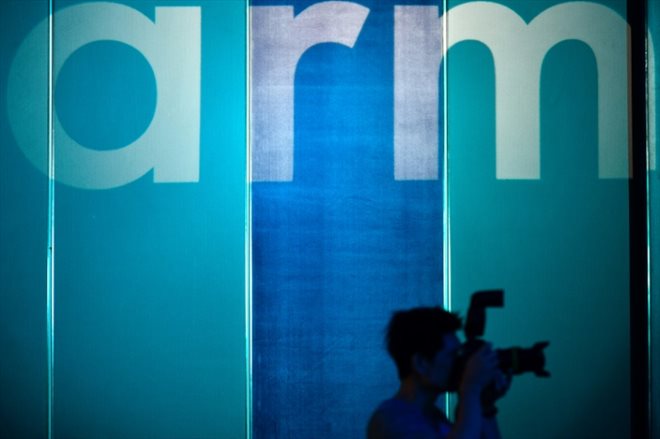Arm’s logo in Taipei in May 2019 (AFP/Sam YEH)
British chip designer Arm is set to make its debut on the New York Stock Exchange on Thursday, the biggest IPO in nearly two years, a roughly $50 billion bet for its largest shareholder, SoftBank Group, on a market without certainty.
The operation was initiated by this Japanese investment company, determined to list Arm, a benchmark in microprocessor design, whose models are integrated into 99% of smartphones worldwide.
By selling around 10% of the capital of the technological flagship of Cambridge (England) on the market, SoftBank hopes to recover between 4.5 and 5.2 billion dollars, for a valuation of between 48 and 52 billion dollars.
This is significantly more than the 32 billion paid by the Japanese to take control of Arm in July 2016, but less than the 60 to 70 billion dollars that SoftBank was targeting just a few weeks ago, according to several media.
The stakes are considerable for the company led and founded by Masayoshi Son, whose record has been more than mixed in terms of technological investments in recent years.
SoftBank notably suffered colossal losses on its stakes in the fallen king of shared offices WeWork as well as in the capital of the Chinese online commerce giant Alibaba.
– “Desert crossing” –
“No one disputes that it is a quality company, (…) with substantial profits and a completely viable activity. But the questions concern its growth potential”, advances, regarding Arm, Jay Ritter, professor specializing in IPOs at the University of Florida.
“This valuation at $50 billion does not seem to arouse enthusiasm among institutional investors,” he said.
Some note that Arm designs microprocessors, or CPUs, while the generative artificial intelligence (AI) revolution relies on more powerful GPUs, graphics cards.
It is also a life-size test for the capital markets, which have not experienced a similar introduction since the turn of the American electric vehicle manufacturer Rivian, valued at $77 billion in November 2021.
“To say it’s highly anticipated would be an understatement,” said Mark Roberts, managing partner at Blueshirt Capital Advisors. “We are coming out of a desert crossing like I have never seen in my career, especially for technology stocks.”
During the 18 months from the start of 2022 to June 2023, around 18.7 billion dollars were raised on the stock market in the United States, compared to 155.8 billion in 2021 alone, according to the firm EY.
You have to go back to 1990 to find figures lower than those of the 2022 vintage.
– “We need more” –
Mark Roberts highlights the number of banks participating in this launch, no less than 27. “A good part of Wall Street is doing everything to ensure that this goes through correctly,” he says, especially since Arm has bet on Wall Street rather than London.
Another precaution, SoftBank has brought together a group of prestigious clients, from Apple to Nvidia, ready to invest $735 million in Arm’s capital.
“If the transaction goes well, it will be a good harbinger of a trend that will continue in 2024”, anticipates Mark Roberts.
“I’m not sure that this introduction will really tell us much” about the state of the market, tempers Avery Spear, analyst at the specialized firm Renaissance Capital.
“We need more,” she says, “like Instacart or Klaviyo, to give us more information about the appetite for the majority of companies wanting to list.”
Instacart (by its parent company Maplebear), a grocery delivery platform, and Klaviyo, an online marketing specialist, both formally submitted their application for introduction at the end of August, without announcing a date.
Their valuations are estimated at $10 billion and $9.5 billion, respectively.
Also circulating this year were the names of the online payments company Stripe, the sports merchandising giant Fanatics, and the professional expense manager Navan.
The environment remains fragile, especially as the US economy is decelerating.
“Investors remain vigilant, but we are not at the same point as last year, where everything was unfavorable,” recalls Avery Spear, first and foremost the rise in rates, dictated by central banks.
There is general agreement that the cycle of monetary tightening is about to end, which offers visibility to operators, who, according to the analyst, “have digested”.
© 2023 AFP
Did you like this article ? Share it with your friends using the buttons below.




